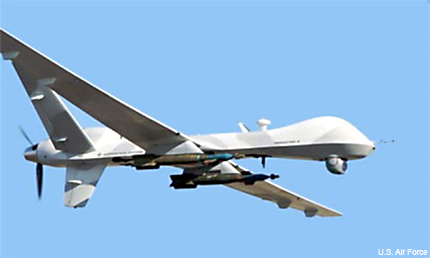Future of unmanned capabilities: MALE vs HALE
While the U.S. has had a lot of success with medium-altitude unmanned aircraft against non-state actors, more technologically formidable militaries such as China's could be a problem.

The MQ-9 Reaper, a medium-altitude drone, is favored for its dual surveillance and strike capabilities.
The U.S. military’s “pivot” to the Asian Pacific region could not only further stress its unmanned intelligence, surveillance and reconnaissance (ISR) resources, but it could also affect what types of drones it uses.
To date, the military services have demonstrated a preference for medium-altitude, rather than high-altitude, land-based unmanned aircraft due to their combined surveillance and strike capabilities. But that could present complications as the Pentagon shifts its focus to the Asian Pacific.
According to recent figures, the military will purchase 29 new MQ-9 Reaper drones, which belong to the Air Force, along with an Army variant called the MQ-1C Gray Eagle. The Reaper, which has become a favored tool of the military and CIA given its dual ISR/strike capability, is considered a medium-altitude, long endurance, or MALE, aircraft. Aircraft that fall into this class have a general altitude ceiling of between 25,000 and 50,000 feet and are capable of 24-hour missions.
High-altitude, long-endurance (HALE) aircraft by contrast are typically capable of flying as high as 60,000 feet and can endure missions as long as 32 hours. But they are not weaponized. The two primary HALE aircrafts the military currently operate are the Air Force’s land-based RQ-4 Global Hawk and the Navy’s MQ-4 Triton, the maritime variant of the Global Hawk. The Air Force will not be procuring any additional Global Hawks for higher altitude ISR. Rather, it was announced recently that the Air Force will spend up to $4 billion on upgrades and retro fits for the Global Hawk as a type of short-term fix imposed by budget cuts and battles with Congress over the continued use of the military’s (but not Congress’) favored high-altitude ISR aircraft, the manned U-2. The Navy, on the other hand, will buy at least four Tritons to be built in 2016, but quantities will decrease due to budgetary restrictions—this as the U.S. shifts towards a greater maritime focus.
The Reaper and its predecessor model, the MQ-1 Predator, have engendered great successes for the military in the fight against non-state actors in several regions spanning across North Africa to South Asia. The ability of these aircraft to loiter 24/7 provides operators with constant surveillance that, combined with the strike capability, makes these MALE aircraft a highly effective tool. However, non-state actors do not possess advanced radar systems or capable anti-aircraft systems that pose any type of anti-access area denial (A2/AD) for U.S. unmanned operations.
Conversely, modern militaries such as China’s People’s Liberation Army have those advanced capabilities that can pose A2/AD threats. The Asia-Pacific pivot is aimed at, among other things, ensuring greater security partnerships with regional allies such as Japan and South Korea. China’s capabilities could hinder ISR operations in the Pacific in ways the U.S. has not had to deal with elsewhere. China recently bought the S-400 air defense system from Russia. The system is capable of shooting down aircraft, ballistic and cruise missiles within a range of 248.5 miles. The move is thought to signify a further aggressive posture for dominance in the region and against certain territories. Military leaders have already warned of the A2/AD problems facing a Pacific shift, and these systems will compound the problem.
In a 2010 paper for the Navy War College, then Air Force Maj. Christopher J. McCarthy noted, “In the event U.S. forces successfully penetrate the anti-access shield, Chinese area denial assets will prevent U.S. airpower from attaining air superiority to a degree which U.S. forces have become accustomed during recent conflicts.”
While HALE aircraft are capable of flying at higher speeds—roughly over 100 miles per hour faster—and higher than MALE aircraft, they also are not immune to advanced anti-aircraft capability. Other advanced Russian-made anti-aircraft capabilities include the SA-2 surface-to-air missile, which famously shot down a U-2 plane in 1960 (a U-2 can fly at the near-space atmospheric altitude of 70,000 feet).
The United States faces complex threats from several different actors, each with unique capabilities. While UAVs have been successful against non-state actors, they might not be as effective against other adversaries. The UAV strategy is likely to change in the Pacific against a more technologically savvy threat such as China. “Swarming” capabilities are one such manner in which UAVs might prove effective against advanced radar and antiaircraft capability, though these types of UAVs will be much smaller.
“Temporary, local control of the air and sea is a much more realistic expectation, and may be achieved through focused application of selected principles of war and by balancing operational factors,” McCarthy wrote. “For example, the massing of selected U.S. forces at a particular time and location will create opportunities to surprise, saturate and overwhelm air defenses, creating a temporary positional advantage in which specific objectives may be achieved.”
The Defense Advanced Research Projects Agency has also developed a similar concept called the System of Systems Integration Technology and Experimentation (SoSITE) program, in which a fighter aircraft approaching enemy radars and missile defenses is aided by a larger aircraft—akin to a C130—that can deploy small UAVs controlled by the manned fighter jet to distract and overwhelm enemy defenses allowing friendly access into a contested zone.